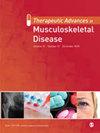Knee osteoarthritis: disease burden, available treatments, and emerging options
IF 3.4
2区 医学
Q2 RHEUMATOLOGY
引用次数: 0
Abstract
Osteoarthritis (OA) is a prevalent condition that affects nearly 528 million people worldwide, including 23% of the global population aged ⩾40, and is characterized by progressive damage to articular cartilage, which often leads to substantial pain, stiffness, and reduced mobility for affected patients. Pain related to OA is a barrier to maintaining physical activity and a leading cause of disability, accounting for 2.4% of all years lived with disability globally, reducing the ability to work in 66% of US patients with OA and increasing absenteeism in 21% of US patients with OA. The joint most commonly involved in OA is the knee, which is affected in about 60%–85% of all OA cases. The aging population and longer life expectancy, coupled with earlier and younger diagnoses, translate into a growing cohort of symptomatic patients in need of alternatives to surgery. Despite the large number of patients with knee OA (OAK) worldwide, the high degree of variability in patient presentation can lead to challenges in diagnosis and treatment. Multiple society guidelines recommend therapies for OAK, but departures from guidelines by healthcare professionals in clinical settings reflect a discordance between evidence-based treatment algorithms and routine clinical practice. Furthermore, disease-modifying pharmacotherapies are limited, and treatment for OAK often focuses solely on symptom relief, rather than underlying causes. In this narrative review, we summarize the patient journey, analyze current disease burden and nonsurgical therapy recommendations for OAK, and highlight emerging and promising therapies—such as cryoneurolysis, long-acting corticosteroids, and gene therapies—for this debilitating condition.膝关节骨关节炎:疾病负担、现有治疗方法和新出现的选择方案
骨关节炎(OA)是一种影响全球近 5.28 亿人的常见疾病,包括全球 23% 的 40 岁以上人口,其特征是关节软骨的逐渐损伤,通常会导致患者出现剧烈疼痛、僵硬和活动能力下降。与 OA 相关的疼痛是维持身体活动的障碍,也是导致残疾的主要原因,占全球残疾生活年限的 2.4%,66% 的美国 OA 患者的工作能力下降,21% 的美国 OA 患者的缺勤率增加。OA 最常累及的关节是膝关节,约有 60%-85% 的 OA 患者都受到了膝关节的影响。人口老龄化和预期寿命的延长,加上诊断时间的提前和年轻化,导致需要手术治疗的无症状患者越来越多。尽管全球膝关节 OA(OAK)患者人数众多,但患者表现的高度差异性会给诊断和治疗带来挑战。多个学会的指南都推荐了 OAK 的治疗方法,但临床中医护人员偏离指南的做法反映出循证治疗算法与常规临床实践之间的不一致。此外,改变病情的药物疗法也很有限,OAK的治疗往往只侧重于缓解症状,而不是根本原因。在这篇叙述性综述中,我们总结了患者的治疗历程,分析了当前的疾病负担和针对OAK的非手术疗法建议,并重点介绍了针对这种使人衰弱的病症的新兴疗法和前景看好的疗法,如冷冻神经溶解术、长效皮质类固醇激素和基因疗法。
本文章由计算机程序翻译,如有差异,请以英文原文为准。
求助全文
约1分钟内获得全文
求助全文
来源期刊

Therapeutic Advances in Musculoskeletal Disease
Medicine-Rheumatology
CiteScore
6.80
自引率
4.80%
发文量
132
审稿时长
18 weeks
期刊介绍:
Therapeutic Advances in Musculoskeletal Disease delivers the highest quality peer-reviewed articles, reviews, and scholarly comment on pioneering efforts and innovative studies across all areas of musculoskeletal disease.
 求助内容:
求助内容: 应助结果提醒方式:
应助结果提醒方式:


